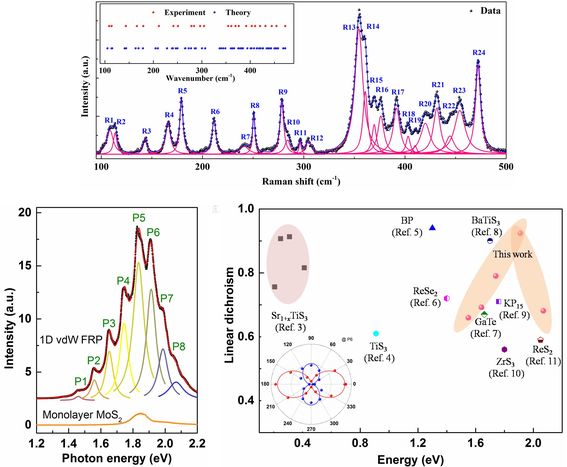One-dimensional red phosphorous glows in unexpected ways

When electrons are confined into very small spaces, they can exhibit unusual electrical, optical and magnetic behaviour. From confining electrons in two-dimensional atomic sheet graphene – a feat that won the Nobel Prize in physics in 2010 – to restricting electrons even further to achieve one-dimensionality, this broad line of research is transforming the landscape of fundamental research and technological advances in physics, chemistry, energy harvesting, information and beyond.
In a study published in Nature Communications, an international team led by Aalto University researchers has now found that fibrous red phosphorous, when electrons are confined in its one-dimensional sub-units, can show large optical responses – that is, the material shows strong photoluminescence under light irradiation. Red phosphorous, like graphene, belongs to a unique group of materials called one-dimensional van der Waals (1D vdW) materials. A 1D vdW material is a radically new type of material that was discovered only in 2017. Until now, research on 1vdW materials has focused on electrical properties.
The team uncovered the optical properties of 1D vdW fibrous red phosphorous through measurements like photoluminescence spectroscopy, where they shone laser light on the samples and measured the colour and brightness of the light emitted back. The findings show the 1D vdW material demonstrates giant anisotropic linear and non-linear optical responses – in other words, the optical responses strongly depend on the orientation of the fibrous phosphorous crystal – as well as emission intensity, which relates to the number of photons emitted during a specific time.
‘The way it responded in the experiments makes 1D vdW fibrous red phosphorus a really exciting material. For example, it shows both giant anisotropic linear and non-linear responses as well as emission intensity, which is striking,’ says Dr Luojun Du, a postdoctoral researcher at Aalto University.
The material’s photoluminescence – the effect commonly seen in everyday life in reflective signs or children’s glow-in-the-dark toys, when light is emitted after absorption – also struck the researchers by surprise. The team compared the photoluminescence of fibrous red phosphorous with monolayer molybdenum disulfide (MoS2), which is well-known for its strong photoluminescence, and found that the intensity of the photoluminescence was more than 40 times more intense, making it ultra-bright – albeit very briefly.
‘The strong photoluminescence of fibrous red phosphorus is unexpected. In fact, we initially expected that the photoluminescence of fibrous red phosphorous would be only weak. Based on theoretical calculations, this effect shouldn’t actually be strong so we’re now doing more experiments to clarify the origin of its after-glow,’ says Du.
‘I believe that one-dimensional van der Waals materials like fibrous red phosphorous show real promise for displays and other applications, which rely on materials that demonstrate exactly the behaviours we’ve seen in this study. The spectrum of its anisotropic optical response also seems to be very wide if we compare it with responses from conventional materials,’ says Professor Zhipei Sun, who leads the group behind the study.
The study was published in Nature Communications on 10 August 2021.
More information:
Luojun Du
Postdoctoral researcher
Aalto University
+358406817981
luojun.du@aalto.fi
Zhipei Sun
Professor, Photonics
Aalto University
+358504302820
zhipei.sun@aalto.fi

Upper panel: Raman spectra of fibrous red phosphorous.
Bottom left panel: photoluminescence of fibrous red phosphorous, compared with monolayer MoS2.
Bottom left panel: The comparison of linear dichroism of fibrous red phosphorous with other well-known materials.
Read more news

Major funding powers development of next-generation machine technology aimed at productivity leap in export sectors
The BEST research project is developing new types of sealing, bearing, and damping technology.
The TAIMI project builds an equal working life – a six-year consortium project seeks solutions to recruitment and skill challenges
Artificial intelligence (AI) is changing skill requirements, the population is aging, and the labor shortage is deepening. Meanwhile, the potential of international experts often remains unused in Finland. These challenges in working life are addressed by the six-year TAIMI project funded by the Strategic Research Council, and implemented by a broad consortium.
Unite! Seed Fund 2026: Call opens on 20 January 2026
Gain an early overview of the Unite! Seed Fund Call of Spring 2026. The call includes three funding lines: Student Activities, Teaching and Learning, and Research and PhD.






